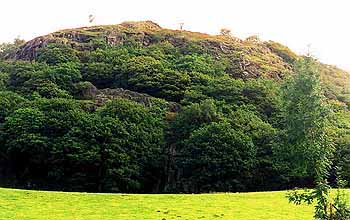
EBK Home
Kingdoms
Royalty
Saints
Pedigrees
Archaeology
King Arthur
Mail David
 DINAS
EMRYS
DINAS
EMRYSVortigern's Hide-Out?
The Tradition: The Mabinogion tells us that Dinas Emrys was the place where the Celtic God of Health & Healing, Lludd Llaw Ereint (the Silver-Handed) buried two fighting dragons on the advice of his brother Llefelys. Nennius, followed by Geoffrey of Monmouth, further wrote how centuries later, when the High-King Vortigern fled into Wales to escape the Saxon hoards, he chose this lofty hillfort as the site for his Royal Retreat. Every day his men would work hard erecting the first of several proposed towers for the palace; but the next morning they would return to find the masonry collapsed in a heap. This continued for many weeks until Vortigern was advised to seek the help of a young orphan boy born of the fairies. The King sent his soldiers out across the land to find such a lad. They were eventually successful at the city which became known as Caer Myrddin (Carmarthen). The boy was called Myrddin Emrys, better known as Merlin today. He told Vortigern of the dragons fighting within the hillside beneath a pool and, when they were uncovered, he explained how the White Dragon of the Saxons though winning the battle at present, would soon be defeated by the British Red Dragon. After Vortigern's downfall, the fort was given to High-King Ambrosius Aurelianus alias Emrys Wledig (the Imperator), hence its name.
 Modern
Archaeology: Excavations in
the mid-1950s revealed that the Dinas Emrys was occupied to some extent in
the late Roman period, but that rough stone banks around its Western end
are later. They were poorly built of stone two or three times and took
strategic advantage of natural crags. Further still less substantial walls
were also discovered to the north and south. Broken sherds of Eastern
Mediterranean amphorae, Phoenician red slip dishes and a pottery lamp
roundel featuring a Chi-Rho symbol indicate that these features do indeed
date to the 5th and 6th century. The was also evidence of iron-working and
buildings of uncertain date were clustered around a central pool. Later
occupation was evidenced by the footings of the tower of a 12th century
Castle Keep.
Modern
Archaeology: Excavations in
the mid-1950s revealed that the Dinas Emrys was occupied to some extent in
the late Roman period, but that rough stone banks around its Western end
are later. They were poorly built of stone two or three times and took
strategic advantage of natural crags. Further still less substantial walls
were also discovered to the north and south. Broken sherds of Eastern
Mediterranean amphorae, Phoenician red slip dishes and a pottery lamp
roundel featuring a Chi-Rho symbol indicate that these features do indeed
date to the 5th and 6th century. The was also evidence of iron-working and
buildings of uncertain date were clustered around a central pool. Later
occupation was evidenced by the footings of the tower of a 12th century
Castle Keep.
 Possible
Interpretations:
It appears that tradition was correct in insisting that this
hillfort site was once a Dark Age residence. Details of the pool and tower
(though admittedly later) indicate a continuing memory of when the site
was occupied. Certainly it housed a rich chieftain of some kind in both
the 5th and 6th centuries: one wealthy enough to import wine from far
afield. There would therefore seem to be few reasons to contradict Nennius
in assigning this as the Palace of Vortigern and later, considering the
name, Ambrosius Aurelianus (Emrys Wledig).
Possible
Interpretations:
It appears that tradition was correct in insisting that this
hillfort site was once a Dark Age residence. Details of the pool and tower
(though admittedly later) indicate a continuing memory of when the site
was occupied. Certainly it housed a rich chieftain of some kind in both
the 5th and 6th centuries: one wealthy enough to import wine from far
afield. There would therefore seem to be few reasons to contradict Nennius
in assigning this as the Palace of Vortigern and later, considering the
name, Ambrosius Aurelianus (Emrys Wledig).
